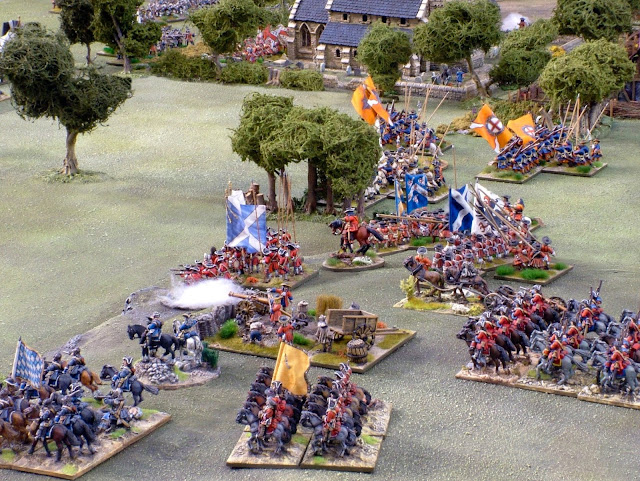The final part of a piece on one of the country's forgotten Lions...
An appraisal of England’s fire eating general
An appraisal of England’s fire eating general
 |
| Cutts probably did not get into the heat of battle at Blenheim but his commanded a large body of the army. |
Cutts on the table top
In a skirmish game John Cutts would
be a fearless leader with a nose for danger. Fond of impetuous charges, close
combat and impossible odds. A character who scorns death and needs no morale
tests. He will win or fight to the death trying. As a colonel leading his
regiment whether that be in Ireland against the Jacobites or Flanders fighting
the French, he should count as a talismanic figure adding both combat and
morale bonuses. Particularly in offensive situations, Cutts should add the
highest possible command modifiers if attached to a battalion.
As a brigadier or major general he
should continue to add top level modifiers where directly attached to a unit.
His wider command ability should perhaps model a man who finds it difficult to
change tack when confronted with a serious problem. This may mean negative
modifiers are applied if he is ordered to call off an attack, retreat or defend
a position rather than take the fight to the enemy. If commanding a formation
larger than a brigade, then either no differentiators from other average
ability generals should be applied or alternatively, the negatives mentioned at
brigade level should be used.
 |
| 1689-1695 was the Golden Age of the man - battlefield hero but perhaps less successful in other aspects of life. |
Cutts can be legitimately dropped
into battle with a variety of opponents from Ottoman Turks and their vassal
Transylvanian allies to Jacobite Irish regulars and rapparees, French troops of
the Nine Years War in Flanders or during the War of the Spanish Succession
again in Flanders or on the Danube. There is conjecture that he secretly
participated in the Monmouth Rebellion but later denied it. Maybe he could
appear under a nom de guerre fighting against his lawful king in some West
Country scenarios. He refused the
governorship of Jamaica and was turned down flat for a similar position in the
American colonies so for ‘What if’ fans – how about Caribbean Cutts or Cutts
versus the Canadas?
What do
you think?
 |
| How about Cutts in the Caribees? - He didn't fancy it |
John Cutts died in Dublin on
January 25, 1707 having been in almost continual and massive debt since 1690.
Using the National Archive calculator and equating to a 2017 value of money
equivalent, the debt appears to have run steady at about £1,000,000 rising to
£2,000,000 at its height, throughout a period of nearly twenty years. It is
rumoured that at the time of his death he was in the process of trying to marry
his seventy-seven years old cousin so that her fortune could settle the balance.
She outlived him by six months and changed her will back to support her own
direct dependants.
It is easy to conclude that his level of scorn for personal
risk, almost obsessive quest to be in the most dangerous places and a repeated
return to active service after serious wounding would have made him ripe for
psychiatric analysis. There is no doubting the heights of his bravery and
magnitude of death-defying deeds however, the thrill-seeking derring-do
consistently evinced goes well beyond the extreme boundaries of heroism
occasionally exhibited on a battlefield. Cutts may well have suffered from what
might be described in the modern idiom as, personality issues.
Whether you subscribe to the view of John Cutts in the terms
expressed by Benecio de Toro’s character Fenster from The Usual Suspects when
describing the legendary Keyser Söze as a ‘peerless psycho’ or, you prefer to
see him as a knight errant devoted to the Protestant cause and his king, he is
impossible to ignore. A truly fearless man of action, repeatedly seeking the
hottest spot on the battlefield and engaging in acts verging on insanely
dangerous, he is my candidate for England’s greatest warrior. I don’t know if I
would have liked him much but, I would have relished the opportunity to have seen
the Salamander up close.
